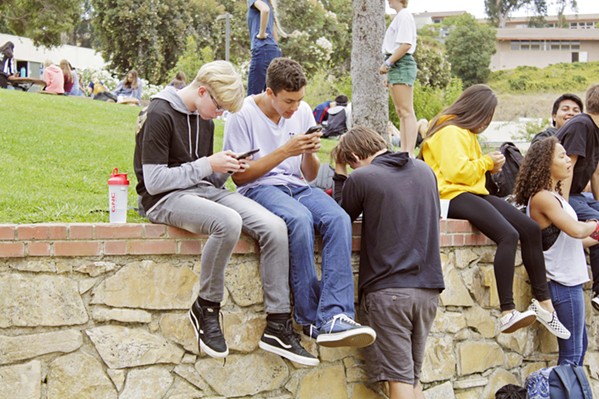SLO, Santa Barbara county school districts partner with local Medi-Cal plan to revamp mental health services on campuses
By Taylor O'connor and Peter Johnson[
{
"name": "Promo Temp Targeted",
"id": "PromoTempTargeted",
"class": "inlineCenter",
"insertPoint": "4",
"component": "15511697",
"requiredCountToDisplay": "0"
},
{
"name": "Ad - Medium Rectangle CC01 - 300x250 - Inline Content",
"class": "inlineCenter",
"insertPoint": "8",
"component": "15582119",
"requiredCountToDisplay": "12"
},{
"name": "Ad - Medium Rectangle LC01 - 300x250 - Inline Content",
"class": "inlineCenter",
"insertPoint": "18",
"component": "15582122",
"requiredCountToDisplay": "22"
},{
"name": "Ad - Medium Rectangle 9 - 300x250 - Inline Content",
"class": "inlineCenter",
"insertPoint": "28",
"component": "15582121",
"requiredCountToDisplay": "32"
}]
Twenty-one percent of San Luis Coastal Unified School District (SLCUSD) ninth graders reported that they seriously considered suicide in 2021.
Another 37 percent said they felt chronically sad or hopeless—a number that has steadily ticked up in recent years, according to California Healthy Kids survey results.
"Student behavioral and mental health needs have increased, and nowhere has it been more clear than coming back from the pandemic," SLCUSD Student Support Services Executive Director Janet Gould told New Times. "There's just a need, and we need to come up with a response."
In a recent push to bolster mental health services, SLCUSD has introduced universal social-emotional screenings for all elementary and middle school students.
But that service isn't provided at the high school campuses, which depend on off-campus counselors and therapists to meet the mental health needs of students. Currently, that need is outpacing the local service capacity.
"What we found at the high schools specifically, [is] we love our community partners, but they're struggling with staffing the same way schools are struggling right now," Gould said. "Having a person to come in on campus is a challenge."
To address those gaps that exists in many Central Coast school districts, SLCUSD and eight other districts in San Luis Obispo and Santa Barbara and counties will partner with CenCal Health—the local Medi-Cal health insurance plan—for the Student Behavioral Health Incentive Program (SBHIP).
A state program, the SBHIP's goal is to strengthen the behavioral health infrastructure in public schools, according to Van Do-Reynoso, CenCal's chief customer experience officer and chief health equity officer.
"We will be working with six local education agencies in Santa Barbara County and three in San Luis Obispo County to improve the infrastructure so there's improved coordination of behavioral health services for students," Do-Reynoso told New Times. "We're looking at staffing, infrastructure, and the capacity so students can get the sustainable behavioral health services they are going to need—not just the students but supportive services for families as well."
Along with SLCUSD, CenCal is partnering with the Lucia Mar Unified, Cuyama Unified, Lompoc Unified, Santa Maria-Bonita, and Carpinteria Unified school districts and the SLO and Santa Barbara county education offices.
Created by the California Department of Health Care Services, SBHIP's long-term aim is to serve Medi-Cal students from transitional kindergarten through 12th grade and ensure that every child receives behavioral health care.
"It's specifically focused on Medi-Cal students because we know Medi-Cal students might have more structural barriers to health access than others. This is an effort to build systems that will support Medi-Cal students," Do-Reynoso said.
The state Department of Health Care Services allocated $389 million over three years for this program as part of Assembly Bill 133—which strives to establish a more equitable and prevention-focused approach to health care, Do-Reynoso said.
For the first two years, CenCal's nine participants will receive SBHIP dollars after which the districts would bill Medi-Cal, similar to insurance claims.
At SLCUSD, the immediate influx of funds means it will be able to hire full-time credentialed counselors at both SLO and Morro Bay high schools for next year.
"That individual will be focused solely on the mental and emotional health of our students," Gould said. "Some of the things they'll be tasked with next year are establishing a 'well space' on our comprehensive high school campuses, implementation of universal social-emotional screening at each high school, [and] they'll provide direct services to students, staff, and families around mental and emotional health."
Longer-term, the SLCUSD and other school districts participating in the program will look to craft a school-based mental health services plan that can be fiscally sustainable under Medi-Cal.
"The whole program has come out of the idea that the state has infused so many dollars into mental health as a result of the pandemic—how do we maintain the funding stream?" Gould said. "[The goal] is to expand the services on campus that we're able to bill Medi-Cal for and be reimbursed."
SBHIP launched in January 2022, and districts started conducting assessments and focus groups to collect initial data to inform the areas they needed to tackle.
"The systemic needs we identified were universal screenings, tiered interventions, information for adults, and developing a closed-loop referral system, and ... ensuring a medical billing procedure is put in place," CenCal's Do-Reynoso said.
School districts often don't have money earmarked for mental health services alone, said Frann Wageneck, co-owner of Flux Coaching and Consulting, a Santa Barbara-based firm that helped identify districts with the highest number of students who were eligible for Medi-Cal.
Creating this program is a step in the right direction, Wageneck said, because districts have often had to get creative with their general funds or their Local Control and Accountability Program funding in order to support mental health services at schools.
"Of course it's not without concerns because there's a lot of work that goes into building those systems [so] that they serve youth in the right way and don't overburden people who are already overburdened with responsibilities," Wageneck said.
Wageneck worked with the school districts on an individual basis to help create tailored plans that would address their mental health needs, she said.
"Santa Maria-Bonita is the largest district in [Santa Barbara] County; Cuyama Unified has 123 students in grades kindergarten through 12th grade. They are going to have very different plans for how we need to roll out their services and create their programs," Wageneck said. "That was the beautiful thing of working with each district."
All participating districts reported depression and anxiety as the main mental health issues students faced, with substance use disorder as a secondary issue for older students, she said.
"That's where the uniqueness of each district comes in. In some areas there really was a need for increasing parental support so we have plan initiatives or interventions focusing ... on increasing in family support and education [through] social workers, family advocates, or a promatora to help support not just students at the school but families as well," Wageneck said.
Gould, with SLCUSD, said that the district is thrilled to be able to revamp its mental health infrastructure through the SBHIP program.
The high school communities are welcoming the new resources with open arms.
"I can tell you that our principal at San Luis High ... he told me that he had one of the students run up to him excited. That's so great," she said. "He had the same type of enthusiastic reaction with the parents.
"Parents are cheering us on and indicating that this is something that will make a difference for the school." Δ
Reach Santa Maria Sun Staff Writer Taylor O'Connor at [email protected] and New Times Assistant Editor Peter Johnson at [email protected].
Latest in News
Readers also liked…
-

SLO police identify alleged driver who hit and killed couple
Dec 22, 2022 -

When the levee breaks: Oceano residents, county officials walk a tightrope of regulations to manage Arroyo Grande Creek, which some say led to the levee's failure in January
May 18, 2023 -

Cal Poly report highlights offshore wind's potential to spur green energy transition
Jun 8, 2023











